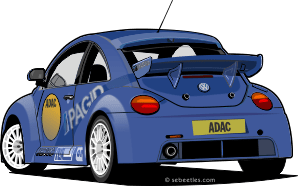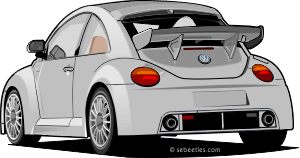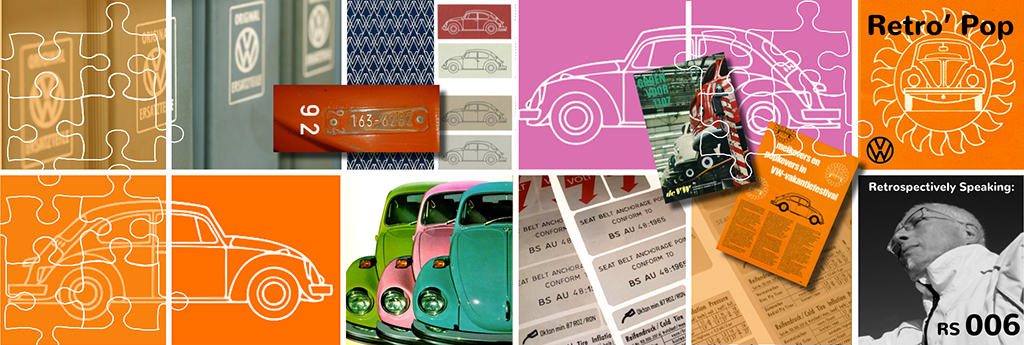Retrospectively Speaking: Retro’ Pop.
One of the fundamental purposes of the SEBeetles website is provide a definitive reference source for Beetle enthusiasts. It is regularly accessed by owners wishing to establish whether a Beetle they own – or are thinking of owning – was in fact a Special Edition model. This research then often leads them to be looking to the site not just for general, background informatives, but also for detailed information to assist the restoration work necessary to put the car back into some assemblance of original condition.
It has surprised me just how many small details about the 1970s era SEBs are still unknown. In retrospect not just small details of well known editions either but of previously unrecorded complete Editions as well.
Research that feeds the regular updating of SEBeetles is a constantly ongoing process. It combines the skills of patient academic research, reliance on long buried subconscious memories and a keen eye for small snippets of information that support turning hunches into fact.
The process seems to combine the roles of murder detective, automotive archeologist and librarian aggregated together with a passion for the subject. It is no wonder that, on occasions, the little grey cells they hurt with the intensity of the concentration needed to follow the clues to a robust conclusion.
Many sources provide input of clues into the process – contemporary and retrospective magazine articles from many sources, Volkswagen literature and documents (including increasingly the Birth Certificate / GebUrtszertifikat service provided by Volkswagenwerke to owners for a fee), photographs and information from owners and paint colour chip cards.
All too often this last source of information comes from the USA in the form of paint manufacturers swatches and colour cards. These feed into one of the consistent, mainline, areas of SEB research. That of paint colours. Work which not only provides directly useful information for restoration projects but also provides main leads on SEB identification. The numberings and codings of paint colours have effectively become the DNA of SEBs.
A significant and increasingly useful source of information assisting our research is that of the now maturing “social media”. Thankfully it has now been elevated by many users above the level of exchanging details of what one is having for breakfast and the previous night’s latest romantic escapades to a form of communication that is outstripped blogging and email exchanges as a readily accessible means of sharing (and seeking) information. It’s success, I believe, is largely because of it’s ease in sharing photographs and text in a very easily used format. A medium of communication infinitely aided of course by the dramatic increases in mobile phone and more recently tablet technology.
Input into our SEB research work comes now very regularly from the dedicated SEB Facebook Group as well as from several other Facebook Groups that cater either for the air-cooled and water cooled Beetle generations or for specific SEB Editions.
It is in that dedicated SEB Facebook Group that I am often heard referring to the analogous jigsaw puzzle. Each little snippet of information, however small, adds a new piece of information to the overall picture. But as with any jigsaw puzzle made up of a substantial number of pieces it is sometimes entirely possible to start trying to fit them in the wrong place in the puzzle until incompatibility with adjacent pieces becomes apparent. This has been the case several times over the past 12 months when a subsequent, new, piece of information is discovered that changes my previously held understandings. This is a very healthy situation that in turn leads to information on SEBeetles.com being updated and changing on a reasonably regular basis. A case in point was the unravelling of what were generally perceived to be Silver second series Big Beetles actually being Luxury Beetles.
What is probably not generally appreciated, for there is no reason why it should be, is the iceberg phenomenon that underpins all SEB research. What gets seen on the surface – on the website – is supported below the surface by a massive amount of underpinning research time.
That research takes many forms but includes looking for patterns as described in RS 005 and using the jigsaw puzzle analogy of having a pile of pieces set aside that do not seem to fit anywhere in the picture until a new, key (or King Pin), piece provides some sense and reason to some of those pieces “in waiting” and allows them to then be placed into the overall picture.
Another very important aspect of SEB research is in the teamwork that has built up. The proverbial “two heads are better than one…” is so true in this respect. How often have we all studied something so hard that we cannot “see” what we are looking for, or conversely, seen something that is obvious to us yet that is something another observer cannot see. I have been fortunate to have had the support and input from several dedicated SEB enthusiasts that have patiently sourced photos or data for me on apparently obscure matters over the past 18 months. In particular I have been honoured to have been working with Austrian based enthusiast Jan Walter on an increasing number of frustrating (RS 003) and seemingly incomprehensible threads of SEB research many of which are still ongoing.
Without that support and team work SEBeetles would not have had the issue of the “Luxury Beetle” and many other things still being worked on now definitively catalogued for the benefit of successive generations of SEB owners. I am still learning, generally daily, about my personal specialist subject and anticipate that I will be doing so for all the rest of my life.
Then there is the cornerstone of SEBeetles.com: founder and webmaster Colin E.Shinkin whose patience with me is without bounds. Very frequently he will get a message from me in late evening or early (pre-breakfast) morning asking if he can conjure me up some obscure form of graphics or unload yet another few pieces of the jigsaw puzzle onto the website. His worst nightmare is when I contact him with an idea that has occurred to me in the middle of the night that potentially means yet another chunk of website development to cater for, what is to me, a simple naive idea and to him many hours of careful doing whatever web designers do to make it happen. I have a favourite Peanuts cartoon that sums it all up.
 There is a tension (and danger) in being passionate about a subject. New information can lead to impulse and incorrect conclusions. At times I am impatient in my desire to add new information into the subject. Given that for both Colin and I SEBeetles is worked on in our respective hobby time it is not always possible to upgrade all the connections within the website that are affected by the insertion of new information – in, say, the paint tables. To us it is an iterative labour of love. Sadly though on at least one occasion recently it has been perceived as work containing inconsistency worthy of criticism about specific detail that prompted the casting of doubts on the validity of the whole. Thankfully we have more visitors to the site that find our work positively helpful and interesting than find it otherwise.
There is a tension (and danger) in being passionate about a subject. New information can lead to impulse and incorrect conclusions. At times I am impatient in my desire to add new information into the subject. Given that for both Colin and I SEBeetles is worked on in our respective hobby time it is not always possible to upgrade all the connections within the website that are affected by the insertion of new information – in, say, the paint tables. To us it is an iterative labour of love. Sadly though on at least one occasion recently it has been perceived as work containing inconsistency worthy of criticism about specific detail that prompted the casting of doubts on the validity of the whole. Thankfully we have more visitors to the site that find our work positively helpful and interesting than find it otherwise.
What I (try) to do to avert misinformation is use a technique I learn’t nearly 40 years ago at the start of my professional career that included Civil Engineering. The base for any engineering construction is a topographical survey on which scheme drawings are based. The core of that survey work is a simple technique called triangulation. This plots a fixed point by reference to other fixed point with a series of surveyed triangles – the only geometric shape that is robustly exact and fixed by virtue of three measurements only. The same principle applies to SEB research; new information is assessed, or cross referenced, relative to other information and verified by the robustness of connections that can be proven and cited. Hunches and inclinations are good but need to be validated and verified. The only problem is that the process takes time – lots of it.
If I am guilty of anything it is of trying to get new information published as soon as possible which leaves “tidying up loose ends” elsewhere on the site as “work in progress”. If we waited until everything was bolted, screwed and glued tight we probably would never get any new information uploaded.
To the list of research references sources that I cited near to the start of this column I also need to add in old Volkswagen Spare Parts catalogues. We are fortunate that fairly recently these have now been made freely available by Volkswagen as an on-line resource. It takes a lot of time going through them page by page but the detail insights they reveal can be conclusive in those cross checking and verification processes.
Recently the availability of this resource this has seen Jan Walter delving into upholstery colours referenced against Frame (chassis) numbers and model type numbers that eventually doubled checked and verified our hunches about the Big Beetles, Luxury Beetles and Grande Bugs.
Browsing those Spare Parts catalogues has also thrown up thoughts in our minds about how the “S” number relate to the “M” numbers (see SEB ”Articles” for both lists). Until very recently I had been inclined to believe that every SEB conformed to at least one of the factory “S” numbers in some way.
I am now inclined to believe that perhaps the “S” series is effectively a sub-set of the “M” options list. Firstly this would explain why some version of the “M” list include “S” numbers in the first column along with “S” numbers.
Going one step further with this idea that “S” numbers are sub-sets of the “M”options would explain why some SEBs do not appear in the “S” list at all.
What I currently believe is that if an SEB was assembled from standard parts – albeit it in a unique way – it possibly does not have an “S” number. Conversely when an SEB included non-standard pasts the “S” number provided the job ticket as it where for the manufacture of unique trim or accessory items not otherwise used in normal series production.
An example of this train of thought is in one of my favourite SEBs that, in the UK, was called the June Beetle and which may not have a been covered by an “S” number because, from a components point of view, it comprised totally of standard parts and accessories if we accept that albeit from the Karmann palette even the paint colour was a standard item.
I know of only one June Beetle still in existence in the UK and would love to know what information would arrive on its Birth Certificate should the owner commission one.
I sincerely believe that a lot of effort is given to the Birth Certificate process by the team at Volkswagen but we know inaccuracies turn up regularly. For example Phoenix Red has been quoted instead of Tomato Red on the certificates for UK market GT (1300S) Beetles. This specific issue I will return to later.
The Zertifikat process is so helpful in many ways to our research and occasionally throws up information that really challenges us. A perfect example of this came to light a few months ago with a very attractive L54D Marina Blue 1300S Beetle built in December 1972 for a life of duties internal to the perimeter of Volkswagenwerk Wolfsburg. At the foot of the list of factory options that the car was equipped with was “S714” – one of the most commonly seen “S” numbers in connection with SEBs. Yet this Marina Blue Beetle was plainly not an SEB in the context we use the term. That inclusion of “S714” has further challenged my understanding of the use of the “S” codes – currently without any resolution to the conundrum.
However if my thoughts about the “S” numbers being a sub-set of the “M” are correct after all then it may suggest that where an Edition comprised of standard and specially manufactured components those special components were denoted by the “S” number for the production process.
This train of thought is still being cross checked but holds very interesting connotations and implications for recoding the 1970s SEB production history. One way of delving deeper on this will to be to do some visual pattern research by drawing up tables of data.
Another piece of work that I needed to set up was that of tabulating the brochure/production codes for each SEB paint colour.
As far as I am aware no such table exists at present because all paint colour referencing is listed according to it’s “L” number.
Although now started but appearing dauntingly tedious this task may well take me into the months of burning hours by candle light in the darkness of winter evenings. I procrastinated on doing this sub-set of work when assembling the original SEB paint colour tables partly because, at that time, I did not fully appreciate the importance of the brochure/ production code as a means of helping owners with restoration projects – and providing DNA trails that solved mysteries.
Although this tabulation of SEB paint in brochure / production code order is in it’s very early stages the initial drafts have already thrown up an explanation for the erroneous declarations about Phoenix Red being the “red” of the 1300 S based GT Beetle production. One of the several brochure codes that Phoenix Red goes under is the same as that for Tomato Red!
Although I have never found a VW sales brochure that lists Tomato Red together with an associated code in the manner of the normal model series brochures we are certain about it’s number by now having the brochure code from a production plate riveted to a Tomato Red GT. If the Birth Certificate team therefore are working back from a chassis number through to code numbers listed against it. I can easily see how the system had been derailed and the information train sent down the wrong track thanks to one two digit number applying to two different tracks at the junction points.
Once the list of paints indexed by brochure code has been completed a repercussion will be to revise “A guide to finding out the paint colour of your BEETLE” currently in it’s May 2016 second edition into a new third edition.
This unravelling of the Phoenix Red/Tomato Red error has only made possible because several owners responded to my pleas on Facebook for information about production plate codes which were then fed back into the paint colour tables.
Very recently, again whilst looking for patterns and trends I have become inclined to the view that there are connections to the allocation of the brochure/production paint colour codes to the chronological sequencing of Editions – or at least their relative place in SEB production history. This was prompted again by owners responding to pleas for the codes on the production plates affixed to their Beetles. In this way the two UK Sun Beetles, the yellow ones and the orange ones, were found to have consecutive paint production codes of 91 and 92 respectively which may prove further helpful evidence at a later date.
Informing and assisting restoration is, for me, a very important incentive behind much of my SEB research work and in turn fed by information from ongoing restoration work. A superb example of this came recently from discussion on the Facebook Group for (North American) Sun Bug Owners. This discussion evidenced that Harvest Gold was not in fact a North American name for L98C Hellas metallic but a different colour altogether and numbered L99C it’s own right (although confusingly Hellas is also listed on paint manufacturers colour swatches as the name for L99B) Both colours were used on the Sun Bug Edition. Slightly irritatingly late series 1303s (Super Beetles) appear not to have been fitted with production plates during manufacture so a key means of correlating and confirming information isn’t available. Our only hope is to find examples of the flat screen Sun Bugs which may still have production plates riveted to the bodywork. The other helpful, but now often missing, clue that helps our research are the small stickers placed inside the front boot area detailing the paint “L” number and name. It was through this route that we were able to be certain about the L98C and L99B issue.
Much of this that I have been describing has come just come together in such a way that we have been able to upload a serious amount of “new” information that has taken a long time to come together.
My affinity with the June Beetle is laid clear in various places on SEBeetles’ and at long last we have been able to replace hunches with factual based certainty that the Edition was part of something bigger than just a VW(GB) Ltd. SEB importation.
We have been able to take small seemingly disconnected and homeless handful of jigsaw puzzle pieces collected from internet photo albums, discussions on TheSamba.com and SEB Facebook threads, old paint chip cards, Emails of enquiry from Norway and put them all together into a fantastic chapter of SEB history bright with the very essence of vibrant colours of the 1970s that followed on from the height of the 1960s psychedelic art . It needed just one single key (or King Pin) piece to make sense of what inclinations and conjecture suggested should be the case – and to open our eyes to other probable evidence which we had not recognised as such despite having been aware of it for years!
That one piece of information was a single A4 sized page in the May 1970 issue of Pon’s internal magazine “de VW” which I discovered last weekend whilst mooching at the 50th Anniversary staging of the now annual Beaulieu International AutoJumble. Just one example that goes to prove that sometimes the evidence, the facts from an indisputable source, may at first glance be almost visually dismissible yet, as on this occasion, they proved to be a very exciting find indeed and effectively the key that opened up a treasure chest.
The page confirmed not only details of two Editions to be marketed in the Netherlands during May 1970 but sufficient additional information that has made it possible for us to be certain about the status of SEBs for other countries made in the same production batch. That information from “deVW” put together with paint chip colour cards and a VW Zertifikat for an Italian Beetle that yet again providing major DNA evidence into the research all came together in a resounding discovery.
I believe the Editions were the first full batch of SEB ever produced – the effective opening chapter of SEB production history.
Manufactured in April 1970 three quarters of the way through the 1970 model year I believe they were the forerunners of several successive “close out” sales campaigns intended to attract purchaser attention – and sales in a period when customers were appearing to be treading water over buying a Beetle in the face of the possibility of more exciting things being unveiled with the new model year in August. In the case of the Spring of 1970 there was already substantial press speculation and rumour about the immanent appearance of an “all new” Beetle. That of course arrived in August 1970 with a VW 1302 badge. Excitingly whilst this 1970 batch of SEBs is now confirmed it raises questions as to which other markets the (effectively) two Editions were supplied to. It also raises questions about a second and possibly third series of one of the Editions being exported to North America in 1971 and again in 1972.
One very thought provoking statistic that has occurred to me over the past twelve months keeps gnawing away in my little grey cells so much so that I need to pose the question to get it out of my head.
How is it that so many the thousands of Special Edition Beetles manufactured between 1970 and 1979 have come and gone without any record of them to be found – especially photographic ones.
If we were talking about a subject from the 1800s of even early 20th Century I might be able to accept the fact. But we are talking about a period, well certainly in 1970-72, of buoyancy, commercial wealth and increasing ownership of personal commodities like cameras in abundance in both Western Europe and North America! So how can it be that it is 99% impossible to find any documentation or photographs of a Pop Lilac Beetle?
Recent confirmations about Pop Lilac and other 1970s “Pop” colours together with recent confirmations about brochure codes for other SEBs are helping to consolidate the 1970 -1979 European SEB paint colour tables now into an almost complete reference source which (I hope) will be an invaluable and lasting resource for restorers.
There is the matter however that for several notable Editions restoration by rebuilding and respraying leaves a problem with finishing detail – that of the distinctive, factory applied, satin black pvc trim lines and small auxiliary stickers applied variously over the painted body during factor assembly. Over the past few years restoration stickers, in varying levels of quality and authenticity, have started to become available.
What now delights me in this respect is the level of commitment and passion from UK Jeans Beetle enthusiast Andy Gore who has been working very hard indeed to produce exactingly authentic restoration sticker sets for Jeans Beetles. These include not only the distinctive satin black external side and engine lid markings but also the full set of ancillary advisory and informing stickers applied variously to the Jeans Beetles during manufacture. I am enthused by Andy’s work not only on his tenacity in producing restoration stickers to exacting degrees of authenticity but also by his tireless efforts to trace and catalogue the Jeans Beetles imported into the UK. Enthusiasm like that recharges my batteries when my energy starts to wane.
Appreciation: In addition to my grateful thanks to fellow SEB enthusiast Jan Walter for his encouragement and help with research and information underpinning our joint SEB research work I would also like to say thanks to all SEB enthusiasts who have contributed input into recent ongoing SEB research on paint colour information including those from the GT Beetle, Jeans and Sun Bug Owners Facebook Groups.
Copyright Stephen Paul Hardy,
Dorset, England. 10th September 2016
Further reading on this website:
“Articles” sections E1.0, E1.1, E1.2, E1.3, E1.5, E1.6, Retrospectively Speaking 003 and 005
Individual SEB profiles for the 1970 May, Pop and June Beetles and the 1971 Pop Bug.
[fbls]








